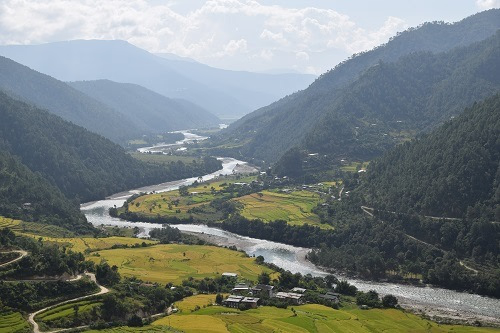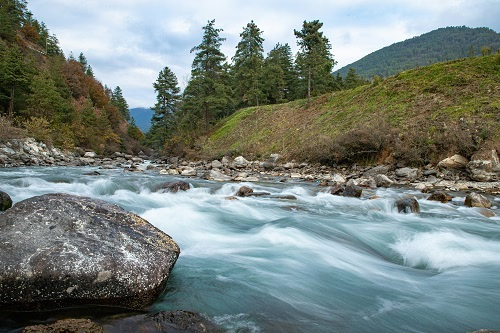
Image Source
Have you ever wondered where Bhutan is located? This small, landlocked country tucked away in the Eastern Himalayas is a hidden gem waiting to be discovered. Bhutan's unique geography and strategic location make it a fascinating destination for travelers and geography enthusiasts alike. In this quick geography lesson, we will explore Bhutan's location on the world map, its neighboring countries, and the geographical features that shape its landscape.
Bhutan's Geographical Location on the World Map
Bhutan, often referred to as the "Land of the Thunder Dragon," is nestled in the heart of Asia. Located in the southern part of the continent, Bhutan shares its borders with two countries: India to the south, east, and west, and China to the north. To visualize Bhutan's position, take a look at the map below:

Image Source
As you can see, Bhutan is a small country, covering approximately 38,394 square kilometers. Despite its size, Bhutan's strategic location has played a significant role in shaping its history, culture, and relationship with its neighboring countries.
Neighboring Countries
Bhutan's immediate neighbors are India and China, both of which have had a profound influence on the country. To the south, Bhutan shares a border with India, spanning approximately 659 kilometers. This close proximity has fostered strong cultural, economic, and political ties between the two countries. India serves as an important trading partner for Bhutan, and the border regions facilitate cross-border movement and cultural exchange.
To the north, Bhutan's border with China, specifically the Tibet Autonomous Region, stretches across approximately 477 kilometers. While Bhutan and China do not have extensive political or economic interactions, the border remains significant in terms of geopolitics and regional dynamics. The Chumbi Valley, located in Tibet, lies to the northeast of Bhutan and adds another layer of complexity to the region's geography.
The Eastern Himalayas
One of the most striking features of Bhutan's geography is its location within the Eastern Himalayas. These majestic mountains form a natural boundary between Bhutan and its neighbors. The Himalayas are known for their awe-inspiring peaks, and Bhutan is home to several towering mountains, including Jomolhari, Jitchu Drake, and Kangri.
The Eastern Himalayas not only provide a stunning backdrop for Bhutan's landscape but also play a crucial role in shaping the country's climate. The mountains act as a barrier, influencing weather patterns and creating distinct microclimates throughout the region. Bhutan's high-altitude regions experience colder temperatures and receive heavy snowfall, while the southern valleys enjoy a more moderate climate.
River Systems
Bhutan's geography is also defined by its intricate network of rivers. The country is blessed with four major river systems: Amo Chu, Wang Chu, Drangme Chu, and Sankosh. These rivers originate in the high mountains and flow through Bhutan, eventually joining the Brahmaputra River in India.
The rivers of Bhutan serve multiple purposes. They provide essential water resources for agriculture, supporting the country's predominantly agrarian economy. Additionally, Bhutan harnesses the power of these rivers for hydroelectricity generation, contributing to the nation's renewable energy initiatives.

Image Source
Unique Geography
Bhutan's geography is diverse and offers a range of landscapes to explore. From lush valleys to rugged mountain passes, the country's topography is a sight to behold. The southern regions, bordering India, feature fertile plains and dense forests, while the central and northern areas are characterized by steep valleys and soaring peaks.
Bhutan's commitment to environmental preservation is evident in its vast forest cover. The government has implemented a policy to maintain at least 65-70 percent of the country as woodlands or forests, resulting in a negative carbon footprint. This dedication to sustainability and conservation has earned Bhutan international recognition as an environmentalist's dream.
The country's unique geography is also reflected in its rich biodiversity. Bhutan is home to an incredible array of flora and fauna, with numerous protected areas and national parks. These sanctuaries provide a habitat for endangered species such as the Bengal tiger, snow leopard, and black-necked crane.
Regions Of Bhutan
Bhutan, a landlocked country in Southeast Asia, is renowned for its stunning mountainous landscapes, which are part of the Eastern Himalayas. This unique geographical setting not only defines Bhutan's natural beauty but also plays a crucial role in its culture, biodiversity, and strategic significance.
The country is characterized by its rugged terrain, featuring high mountain ranges and deep valleys, with strategic mountain passes that have historically facilitated trade and cultural exchange.
Northern Bhutan
The northern region is dominated by the Great Himalayas, characterized by glaciated mountain peaks that rise above 7,000 meters (23,000 feet). This area is home to Bhutan's highest peak, Gangkhar Puensum, which stands at 7,570 meters (24,836 feet) and is the highest unclimbed mountain in the world.
The extremely cold climate and high elevation create a unique ecosystem, with alpine meadows and sparse populations of migratory shepherds who tend to livestock in the alpine valleys.
Central Bhutan
Central Bhutan is defined by the Black Mountains, which form a watershed between the major river systems of the Mo Chhu and Drangme Chhu.
The peaks in this region range from 1,500 to 4,925 meters (4,921 to 16,158 feet) and are covered with rich forests, including subalpine conifer and broadleaf forests.
This region is the economic and cultural heart of Bhutan, where most of the population resides, and it features strategic mountain passes that connect various valleys.
Southern Bhutan
The southern region consists of subtropical plains and valleys, characterized by a warmer climate and dense forests. This area is more densely populated compared to the northern and central regions.
The southern foothills serve as a transition zone to the lower elevations, where agriculture thrives due to fertile land and ample water resources from the rivers fed by the Himalayas.
Eastern Bhutan
Eastern Bhutan is less explored and includes districts such as Lhuentse, Mongar, Trashigang, Trashiyangtse, and Pema Gatshel. This region features diverse terrains, from mountainous slopes to flat valleys, and is known for its rich cultural heritage and unique traditions.
The strategic mountain passes in this area have historically facilitated trade routes and cultural exchanges with neighboring regions.
Western Bhutan
Western Bhutan is home to some of the most popular tourist destinations, including Thimphu, Paro, and Punakha. This region features stunning landscapes, including deep valleys and majestic mountains.
The valleys here are crucial for Bhutan's political and economic activities, with strategic mountain passes facilitating access to neighboring regions and enhancing connectivity.
Conclusion About Where is Bhutan Located?
Bhutan's location on the world map is a testament to its exceptional geography. Tucked away in the Eastern Himalayas, this landlocked country shares borders with India and China, each playing a significant role in Bhutan's history and culture. The awe-inspiring mountains, mighty rivers, and diverse landscapes make Bhutan a truly unique destination.
Discover where Bhutan is located and plan your visit with our Bhutan travel packages. Learn about the best time to travel to Bhutan and manage your budget with our Bhutan travel cost guide. For a premium experience, explore our luxury travel in Bhutan options. If you're coming from Malaysia, our guide on travel to Bhutan from Malaysia will be helpful. Druk Asia, the best Bhutan travel agency, is dedicated to making your trip extraordinary.
Frequently Asked Questions About Location Of Bhutan
Is Bhutan A Rich Or Poor Country?
Bhutan is considered a developing country, but it has made significant progress in reducing poverty in recent decades. The country has a Gross National Happiness (GNH) index that prioritizes sustainable development, environmental protection, and good governance over economic growth alone.
Is Bhutan A Hindu Country?
No, Bhutan is not a Hindu country. The dominant religion in Bhutan is Vajrayana Buddhism, which was introduced in the 7th century. Hinduism is practiced by some minority groups, especially in southern Bhutan, but it is not the state religion.
Which Country Does Bhutan Belong To?
Bhutan is an independent country and is not part of any other country. It is a constitutional monarchy located in South Asia, bordered by China to the north and India to the south. Bhutan has been independent throughout its history and has never been conquered, occupied, or governed by an outside power.
What Is The Capital City Of Bhutan?
The capital and largest city of Bhutan is Thimphu. It is located in the western part of the country and serves as the seat of the Bhutanese government.
What Is The Official Language Of Bhutan?
The official language of Bhutan is Dzongkha, which is closely related to the Tibetan language. English is also widely spoken and understood, especially in the education and business sectors.
What Is The Currency Used In Bhutan?
The currency used in Bhutan is the Bhutanese ngultrum (BTN). It is pegged to the Indian rupee at par value, and both currencies are accepted as legal tender in Bhutan.
What Is The Population Of Bhutan?
As of 2024, the population of Bhutan is estimated to be around 791,000 people. The country has a low population density, with most of the population living in the western and central regions.
